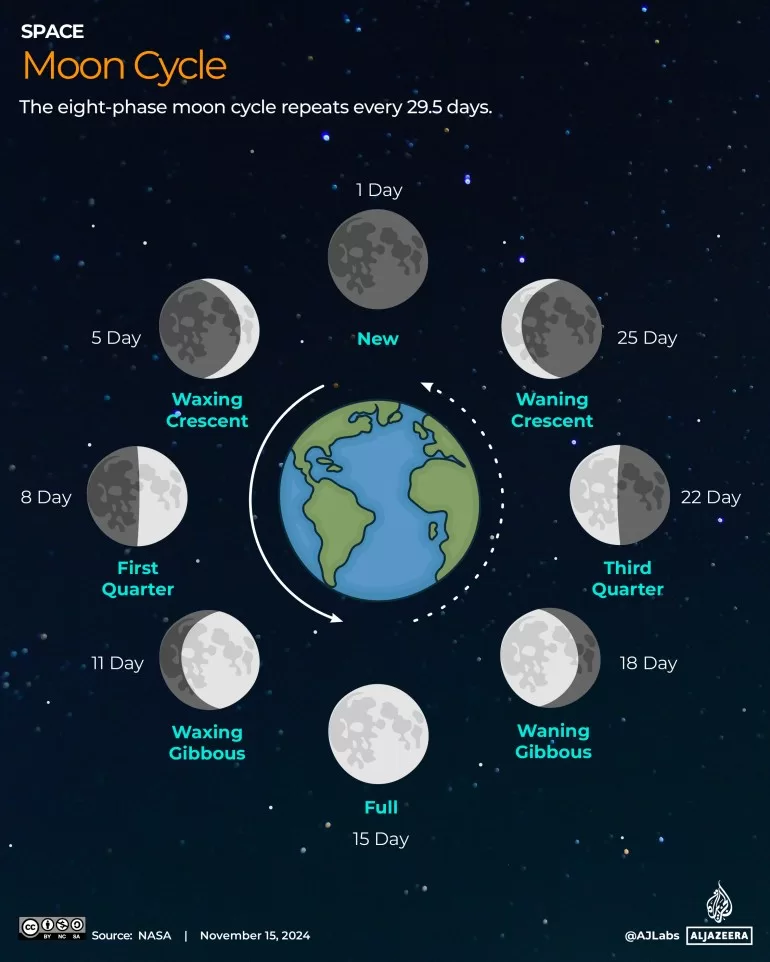The last supermoon of 2024 will be visible worldwide on Friday night.
This supermoon will reach its peak brightness on Friday at 4:29pm Eastern Time (21:29 GMT).
This moon will coincide with other celestial events, including the Leonid meteor shower and the Pleiades star cluster.
Here is what to know:
What is a full moon and supermoon?
According to NASA, a full moon is defined as the moment when the moon is exactly 180 degrees opposite to the sun. In essence, the Earth, moon and sun are all in a line at this point. During this time, the sun is almost fully illuminating the Earth’s satellite.
A supermoon is defined as an astronomical phenomenon where a full moon looks larger and brighter than usual. It happens when the full moon occurs at the same time when it is closest to the Earth in its orbit.
The term “supermoon” was coined by astrologer Richard Nolle in 1979 to describe a full moon that occurs when the moon is “within 90 percent of its closest to Earth”.
At the opposite end of the moon sighting spectrum is the micromoon – when the full moon looks especially small and dull because it coincides with the point in the moon’s orbit when it is farthest from the Earth.

What is the Beaver Moon?
This year’s Beaver Moon will be the fourth and last supermoon of 2024, looking bigger and brighter as it gets closer to Earth, reaching about 361,867km (225,000 miles) away on Thursday.
However, it will reach its full phase on Friday.
Full moons are normally given names that relate to things happening in nature. According to the Old Farmer’s Almanac, this name is also rooted in various traditions and folklore from Native American and European cultures.
In the Northern Hemisphere, this is the season when beavers start settling into their lodges, having stored enough food for the winter.
Some call it the Mourning Moon, as it’s the last full moon before the winter solstice. Other names include the Frost Moon and the Freezing Moon, and those come from the frosts and early snows that begin this time of year, particularly in northeastern North America.
Where and when can you watch it?
Supermoons can be seen worldwide, so peak illumination times will vary by location.
In India, the moon will reach peak illumination at 2:58am (21:29 GMT) on Saturday, while people in London can catch it about 21:29 on Friday local time.
In the Gulf countries of the Middle East, the moon is set to illuminate the skies on Saturday at 00:29 GMT.
Look up! The final #supermoon of the year will be visible tonight 🌙
The #BeaverMoon will light up our skies, and the best viewing conditions are just after #sunset! pic.twitter.com/6IrXiraVqZ
— Australian Geographic (@ausgeo) November 15, 2024
How can you watch the supermoon?
A casual stargazer should be able to see the full moon, if you are in the right time zone.
NASA also recommends using a pair of binoculars “with a magnification of 7 at a minimum”, noting that “a magnification of 10 or 15 will provide more detail; you may need a tripod to steady them.”
The next full moon on Nov. 15 is called a ‘Beaver Moon’
Named after beavers who build their winter dams at this time of year pic.twitter.com/SAgKdpUe2S
— Latest in space (@latestinspace) November 10, 2024
What other celestial events are taking place?
The Leonid meteor shower will also peak this weekend.
The Leonids are known for their fast-moving meteors, which can travel as fast as 70km/second (44 mps). While most meteor showers come from comet debris, the Leonids come from the Tempel-Tuttle comet.
The Leonids are bright meteors and can even appear in different colours. According to NASA, about every 33 years, Earth viewers may witness a Leonid storm, where the meteor count can peak at hundreds or even thousands per hour, depending on the observer’s location.

This full moon will also align with the Pleiades star cluster.
The Pleiades are a recognisable pattern of stars, and an open star cluster consisting of more than 1,000 stars. Situated in the constellation Taurus, they are approximately 410 lightyears from Earth.
This year, the brightness of the full moon may make it difficult to see most of the stars in the cluster. On Saturday at 1:59 am Eastern Time (06:59 GMT), the Full Moon will be just 0°6′ away from the Pleiades.
The Pleiades, captured in infrared light!
In this image, taken by the WISE space telescope, the surrounding dust—visible in infrared—shines even brighter than the stars themselves.
The Pleiades is a star cluster located in the constellation Taurus. pic.twitter.com/xtCcqnHjib
— Black Hole (@konstructivizm) November 11, 2024
